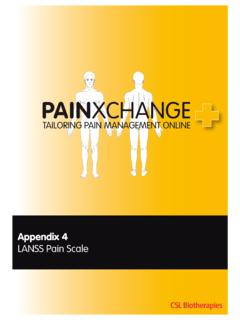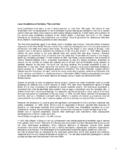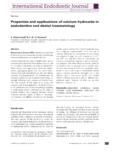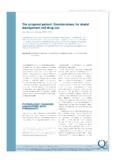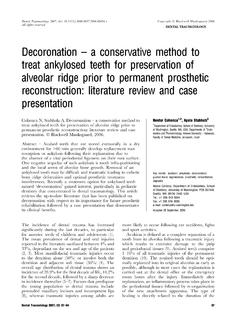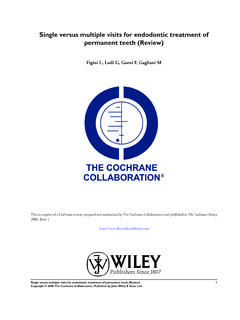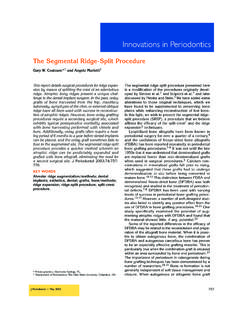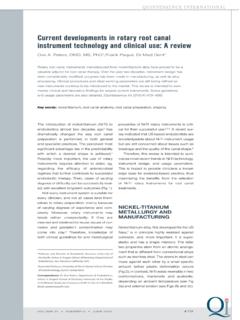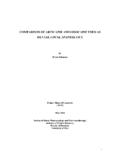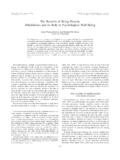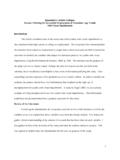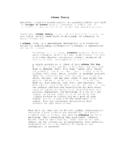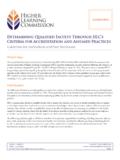Transcription of BioPure MTAD Antibacterial Root Canal Cleanser …
1 BioPure MTAD Antibacterial root Canal Cleanser research Antibacterial 1. Torabinejad M, Shabahang S, Aprecio RM, Kettering JD. The antimicrobial effect of MTAD: An in vitro investigation. J Endodon 2003; 29(6):400-3. Summary: The purpose of this investigation was to test the ability of a mixture of a tetracycline isomer, an acid and detergent (MTAD) to kill Enterococcus faecalis and compare its efficacy to that of NaOCl and ethylene diamine tetraacetic acid (EDTA). The zones of inhibition and minimum inhibitory concentrations were measured for these solutions. Conclusion- Although EDTA demonstrated no Antibacterial effects against E.
2 Faecalis, NaOCl and MTAD proved to be Antibacterial to varying degrees. NaOCl continued to exert its efficacy up to 32x dilutions. On the other hand, MTAD was effective in killing E. faecalis up to 200x dilutions. Furthermore, although a 2 and 5 minute exposure of E. faecalis to undiluted of 1:2 dilution of NaOCl did not result in total killing of bacteria, exposure of the same bacterial species to undiluted or 1:2 diluted MTAD resulted in a completely negative culture after 2 and 5 minutes of exposure. Based on the results of this and previous investigations, it seems that MTAD has the ability to remove most of the smear layer and it posseses superior bacterial activity compared with NaOCl or EDTA when tested against E.
3 Faecalis. These results are significant because they demonstrate the efficacy of an irrigant to remove most of the smear layer and kill a bacterial strain that has been shown to be resistant to many commonly used intracanal irrigants and dressings. 2. Shabahang S, Manouchehr P, Torabinejad M. In Vitro antimicrobial efficacy of MTAD and NaOCI. J Endodon 2003; 29(7):450-2. Summary: The purpose of this study was to compare the ability of MTAD with that of NaOCl to disinfect human root canals that had been contaminated with whole saliva. Conclusion: The results of the investigation confirmed previous findings demonstrating almost 40% of the root canals remain infected using NaOCl and the superior antimicrobial activity of MTAD when compared with NaOCl.
4 An important finding in the study was the ability of MTAD to exert its antimicrobial effect during a brief time. This property is desirable in clinical practice where the root Canal irrigants may be in contact with certain areas of the RCS for a short time. Furthermore, this disinfecting property obviates the need for placement of an intracanal dressing necessitating multiple visits. 3. Shabahang S, Torabinejad, M. Effect of MTAD on Enterococcus faecalis-contaminated root canals of extracted human teeth. J Endodon 2003; 29(9):576-9. Summary: The purpose of this investigation was to compare the antimicrobial effect of MTAD (a mixture of tetracycline isomer, an acid, and a detergent) with that of NaOCl (with and without EDTA) as a final irrigant on E.
5 Faecalis. Conclusion: The results from these samples in the positive control showed that, debridement of root canals using distilled water, is unable to sterilize the root Canal system. The five samples in the negative control groups, which were exposed to the identical microbiological steps as the teeth in the experimental groups, demonstrated that the contamination did not occur during the culturing procedures. Absence of growth on the BHI plates using dentin shavings from this group confirmed that contamination did not occur during the preparation of the shavings. The ineffectiveness of NaOCl to consistently disinfect root canals in this study is in agreement with results from previous investigations.
6 This finding is especially true with E. faecalis, which is a bacterium that is known to resist the Antibacterial effects of certain root Canal medicaments. Although the presence of the smear layer prevents penetration of Antibacterial agents into the dentinal tubules, study results showed that removal of the smear layer with a one minute rinse of 17% EDTA did not enhance the antimicrobial effects of NaOCl. The lack of increased antimicrobial efficacy may be due to the inability of NaOCl to remove the smear layer, its inability to penetrate into the dentinal tubules once the smear layer has been removed, or its ineffectiveness at killing E.
7 Faecalis. Findings also showed that removal of smear layer with a chelating solution (EDTA) that has little or no Antibacterial effect, does not enhance the Antibacterial effect of NaOCl. Fisher s exact test showed that the combination of NaOCl as a root Canal irrigant and MTAD as a final rinse was significantly more effective than the other regimens. The X2 test showed no difference between other regimens. On the basis of these results, it appears that MTAD is an effective final rinse for eradication of E. faecalis from extracted human teeth. 4. University of Helsinki, Finland: E. faecalis culture results in teeth: Siren E, Pedruso E, Haapasalo M.
8 In Vitro disinfection by MTAD, sodium hypochlorite and EDTA of dentin blocks infected by Enterococcus faecalis. Summary: Freshly extracted human premolar, canine and maxillary incisor teeth were incubated in NaOCl overnight for surface disinfection. For infection, the test blocks were stored in each test tube with 5 ml of tryptone soya broth at 37 C with E. faecalis strain ATCC 29212 bacteria. The broth was changed at every 2 to 3 days and the incubation continued for 2 weeks. The irrigating solutions listed (below) were tested for their Antibacterial effect against E. faecalis. EDTA was mixed with water into a 17% solution and the pH was adjusted to by 1N NaOH.
9 NaOCl was diluted from a 5% stock solution obtained by prescription from the pharmacist. All solutions were freshly prepared before the experiments. a. MTAD ( BioPure , 100% solution) 10 min b. NaOCl + MTAD (5 + 5 min) c. EDTA 17 % + NaOCl (5 + 5 min) d. Sterile water (control) (10 min) e. MTAD 60 min f. NaOCl + MTAD (5 + 55 min) Bacterial killing was tested by removing sequential 100 micrometer thick layers of dentine with a sterile bur, starting from the main Canal towards the periphery of the dentin block. Samples were taken to the depth of 450 micrometers and cultured immediately on culture media and checked for growth at 24 and 48 hours.
10 The average number of bacteria per sample in the first zone was 20,266 31,390 (mean SD) for sterile water. For the BioPure MTAD treatment for 10 minutes (without NaOCl), the average number of cells in the first zone was greatly reduced as compared to the control, the average being less than 1 % of the control values, 108 135 per sample. With E. faecalis A197A weak growth was detected in only one sample in the MTAD 10 min group (Group 1) using the tryptone soya broth culture (non-quantitative test). No growth was detected in the samples taken from the other groups. Summary of E. faecalis culture results in teeth: Both research groups (Loma Linda (surface disinfection) and the University of Helsinki, Finland (dentin block disinfection)) determined that E.
